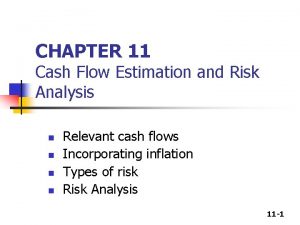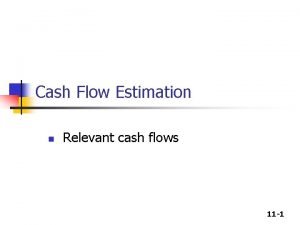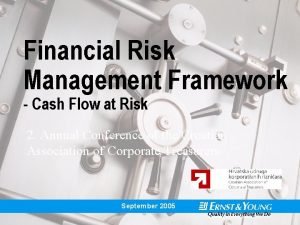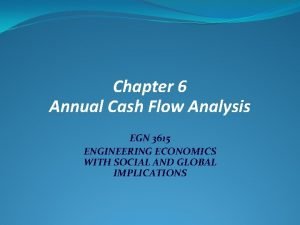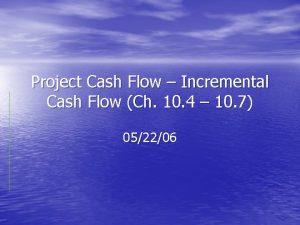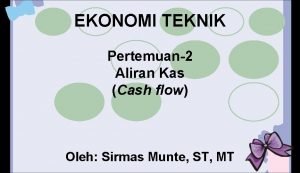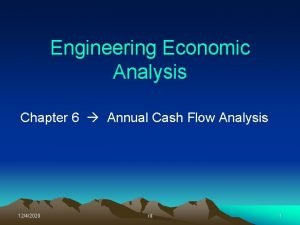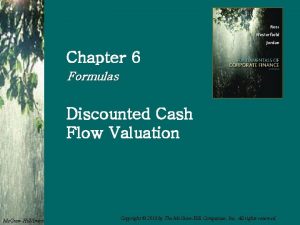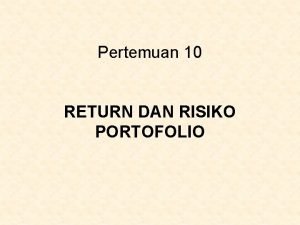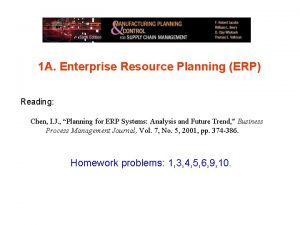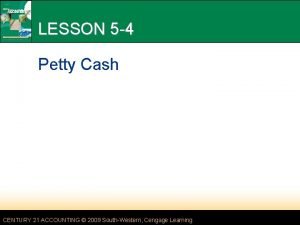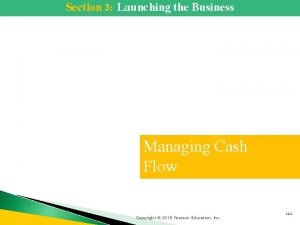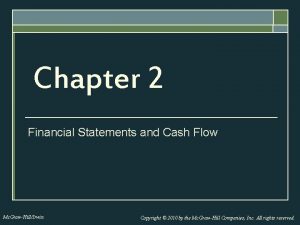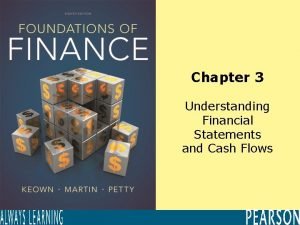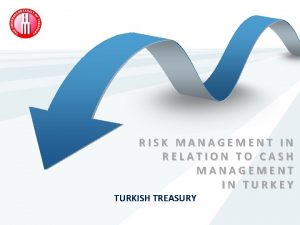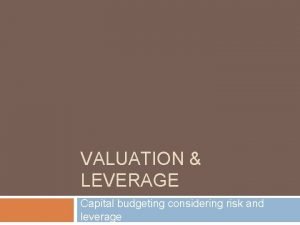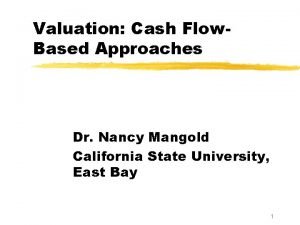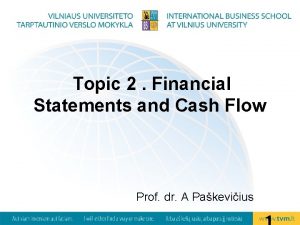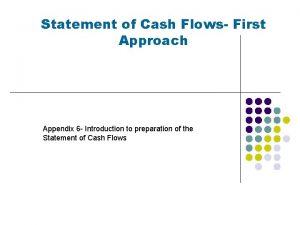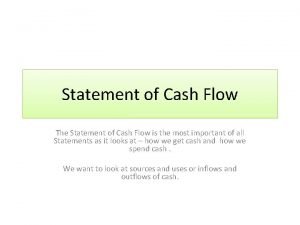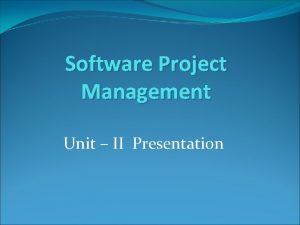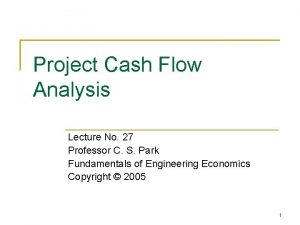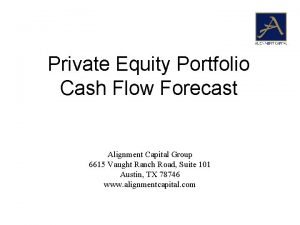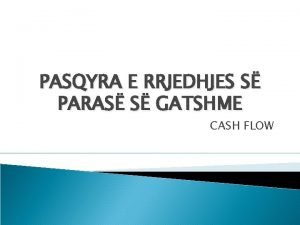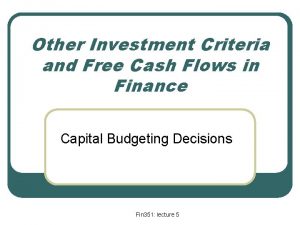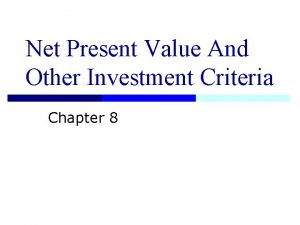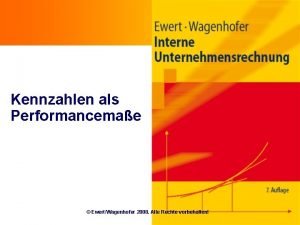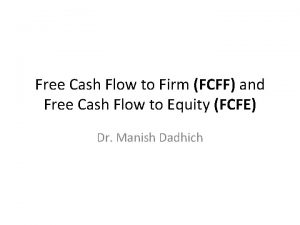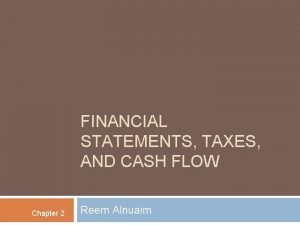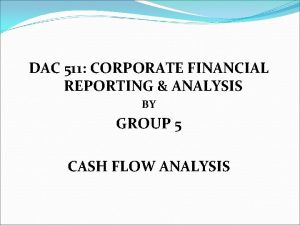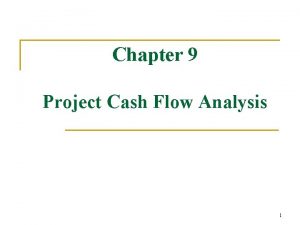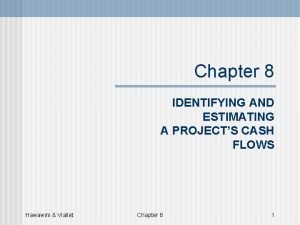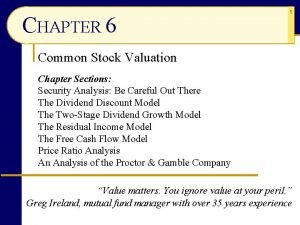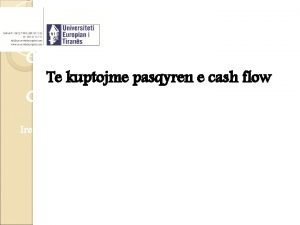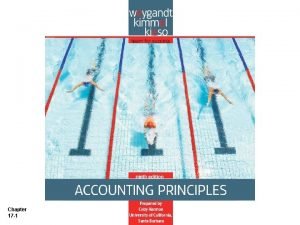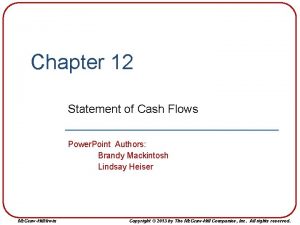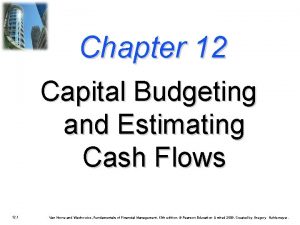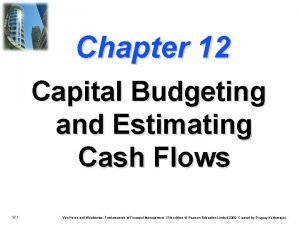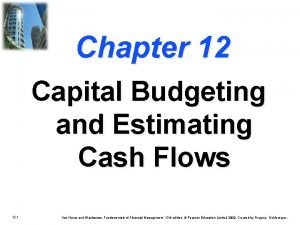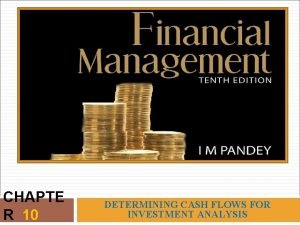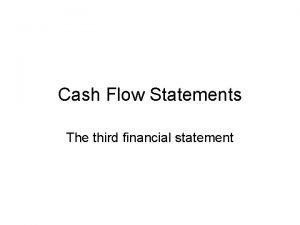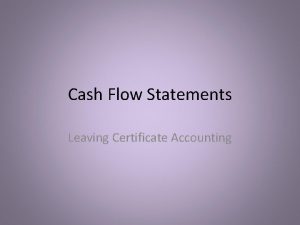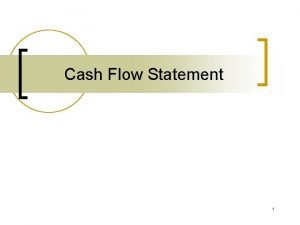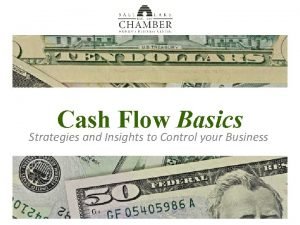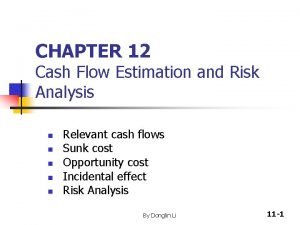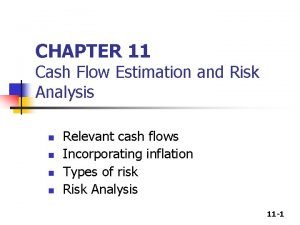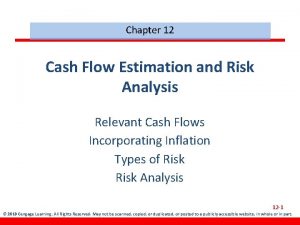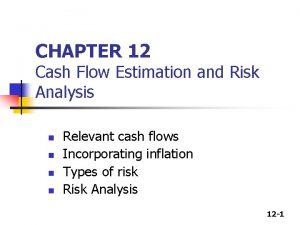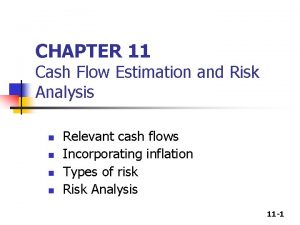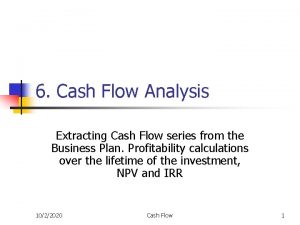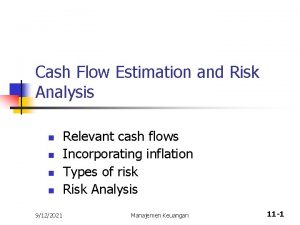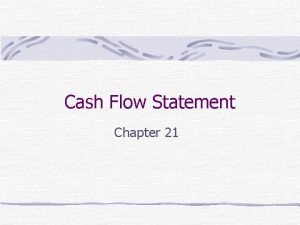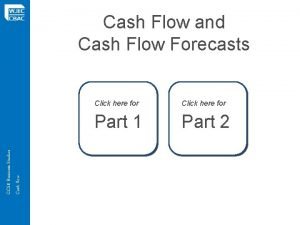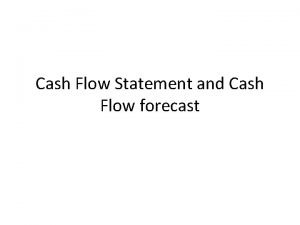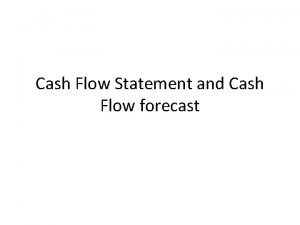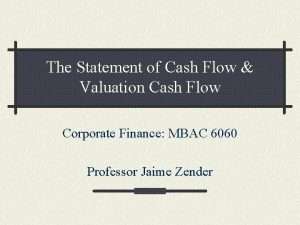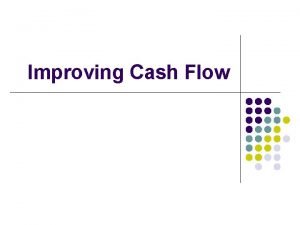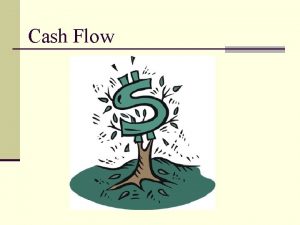Chapter 12 Cash Flow Estimation and Risk Analysis































































- Slides: 63

Chapter 12 Cash Flow Estimation and Risk Analysis § RELEVANT CASH FLOWS § INCORPORATING INFLATION § TYPES OF RISK § RISK ANALYSIS Dr. Mohammad Alkhamis Kuwait University - College of Business Administration 1

Review § The value of any asset is a) b) c) d) e) Its book value. Equal to its next year earnings. The present value of its future expected cash flows. Its future expected cash flows. The sum of all future profits. Kuwait University - College of Business Administration 2

Review § Project Z costs $90, 000, its expected net cash inflows are $50, 000 per year for 5 years, and its WACC is 10%. What is the project’s NPV? a) $99, 539. 34 b) $68, 493. 27 c) $118, 493. 27 d) $189, 539. 34 e) $279, 539. 34 Kuwait University - College of Business Administration 3

Review Project Z costs $90, 000, its expected net cash inflows are $50, 000 per year for 5 years, and its WACC is 10%. What is the project’s IRR? a) b) c) d) e) 17. 63 % 41. 82 % 47. 63 % 119. 63 % Can’t solve for IRR Kuwait University - College of Business Administration 4

Important Concepts § § § § Cash Flow vs. Accounting Numbers Timing of Cash Flows Incremental Cash Flows Replacement projects Sunk Costs Opportunity Costs Externalities § Cannibalization § Complementarity Kuwait University - College of Business Administration 5

Free Cash Flow vs. Accounting Income § For capital budgeting purposes, the project’s cash flows, not its accounting income, is the key item. ������ =���� (1−�� )+�� e���������� − (����� �� ���������� +∆������ ) ∆������ = (∆������� − ∆������������ ) § For simplicity we assume investment in fixed assets and net working capital (NWC) occurs in t=0. § [EBIT(1 -T)+Dep. ] is also known as Operating Cash Flows. Kuwait University - College of Business Administration 6

Salvage value § Kuwait University - College of Business Administration 7

Replacement Projects § Incremental cash flows: cash flows that will occur if and only if some specific event occurs. § Expansion projects: where the firm makes an investment, such as a new store. § Replacement projects: where the firm replaces existing assets, generally to reduce costs. Kuwait University - College of Business Administration 8

Sunk costs Sunk cost: it is an outlay that was incurred in the past and cannot be recovered in the future regardless of whether the project under consideration is accepted. § Because sunk costs were incurred in the past and cannot be recovered regardless of whether the project is accepted or rejected, they are not relevant in the capital budgeting analysis. Kuwait University - College of Business Administration 9

Opportunity Costs § The best return that can be earned on assets the firm already owns if those assets are not used for the new project. § If you already own a land should you include its cost in your cash flows? § Yes, and failure to do so would artificially and incorrectly increase the new project’s NPV Kuwait University - College of Business Administration 10

Externalities: the effects of a project on other parts of the firm or the environment. 1. Cannibalization: a new project reduces cash flows that the firm would otherwise have had. 2. Complimentary: cash flows in the old operation will be increased when the new one is introduced. 3. Environmental externalities Kuwait University - College of Business Administration 11

Proposed Project § Total depreciable cost § Equipment: $200, 000 § Shipping and installation: $40, 000 § Changes in working capital § Inventories will rise by $25, 000 § Accounts payable will rise by $5, 000 § Effect on operations § New sales: 100, 000 units/year @ $2/unit § Variable cost: 60% of sales Kuwait University - College of Business Administration 12

Proposed Project § Life of the project § Economic life: 4 years § Depreciable life: MACRS 3 -year class § Salvage value: $25, 000 § Tax rate: 40% § WACC: 10% Kuwait University - College of Business Administration 13

Determining Project Value § Estimate relevant cash flows § Calculating annual operating cash flows. § Identifying changes in working capital. § Calculating terminal cash flows: after-tax salvage value & return of NWC. 0 1 2 3 Initial Costs OCF 1 OCF 2 OCF 3 NCF 0 NCF 1 NCF 2 4 OCF 4 + Terminal CFs NCF 3 Kuwait University - College of Business Administration NCF 4 14

Initial Year Net Cash Flow § Find NWC. § in inventories of $25, 000 § Funded partly by an in A/P of $5, 000 § NWC = $25, 000 – $5, 000 = $20, 000 § Combine NWC with initial costs. Equipment -$200, 000 Installation -40, 000 NWC -20, 000 Net CF 0 -$260, 000 Kuwait University - College of Business Administration 15

Determining Annual Depreciation Expense Year 1 2 3 4 1. 00 Rate 0. 33 0. 45 0. 15 0. 07 x x x Basis $240 240 $240 Deprec. $ 79 108 36 17 Due to the MACRS ½-year convention, a 3 -year asset is depreciated over 4 years. Kuwait University - College of Business Administration 16

Annual Operating Cash Flows (Thousands of dollars) Revenues – Op. costs – Deprec. expense Operating income (EBIT) – Tax (40%) Operating income (after tax) + Deprec. expense Operating CF 1 200. 0 120. 0 79. 2 2 200. 0 120. 0 108. 0 3 200. 0 120. 0 36. 0 4 200. 0 120. 0 16. 8 0. 3 0. 5 79. 2 79. 7 -28. 0 -11. 2 -16. 8 108. 0 91. 2 44. 0 17. 6 26. 4 36. 0 62. 4 63. 2 25. 3 37. 9 16. 8 54. 7 Kuwait University - College of Business Administration 17

Terminal Cash Flow Q. How is NWC recovered? Q. Is there always a tax on SV? Q. Is the tax on SV ever a positive cash flow? Kuwait University - College of Business Administration 18

Should financing effects be included in cash flows? § No, dividends and interest expense should not be included in the analysis. § Financing effects have already been taken into account by discounting cash flows at the WACC of 10%. § Deducting interest expense and dividends would be “double counting” financing costs. Kuwait University - College of Business Administration 19

Should a $50, 000 improvement cost from the previous year be included in the analysis? § No, the building improvement cost is a sunk cost and should not be considered. § This analysis should only include incremental future cash flows. Kuwait University - College of Business Administration 20

If the facility could be leased out for $25, 000 per year, would this affect the analysis? § Yes, by accepting the project, the firm foregoes a possible annual cash flow of $25, 000, which is an opportunity cost to be charged to the project. § The relevant cash flow is the annual after-tax opportunity cost. § A-T opportunity cost: = $25, 000(1 – T) = $25, 000(0. 6) = $15, 000 Kuwait University - College of Business Administration 21

If the new product line decreases the sales of the firm’s other lines, would this affect the analysis? § Yes. The effect on other projects’ CFs is an “externality. ” § Net CF loss per year on other lines would be a cost to this project. § Externalities can be positive (in the case of complements) or negative (substitutes). Kuwait University - College of Business Administration 22

Proposed Project’s Cash Flow Time Line 0 1 2 3 4 -260 79. 7 91. 2 62. 4 89. 7 § Enter CFs into calculator CFLO register, and enter I/YR = 10%. § NPV = -$4. 03 million § IRR = 9. 3% § MIRR = 9. 6% § Payback = 3. 3 years Kuwait University - College of Business Administration 23

If this were a replacement rather than a new project, would the analysis change? § Yes, the old equipment would be sold, and new equipment purchased. § The incremental CFs would be the changes from the old to the new situation. § The relevant depreciation expense would be the change with the new equipment. § If the old machine was sold, the firm would not receive the SV at the end of the machine’s life. This is the opportunity cost for the replacement project. Kuwait University - College of Business Administration 24

Problem 12 -1 Kuwait University - College of Business Administration 12 -25 25

Problem 12 -2 Kuwait University - College of Business Administration 26 26

Problem 12 -8 Kuwait University - College of Business Administration 27 27

Problem 12 -20 Kuwait University - College of Business Administration 28 28

What are the 3 types of project risk? § Stand-alone risk § Corporate risk § Market risk Kuwait University - College of Business Administration 29

What is stand-alone risk? § The project’s total risk, if it were operated independently. § Usually measured by standard deviation (or coefficient of variation). § However, it ignores the firm’s diversification among projects and investor’s diversification among firms. Kuwait University - College of Business Administration 30

What is corporate risk? § The project’s risk when considering the firm’s other projects, i. e. , diversification within the firm. § Corporate risk is a function of the project’s NPV and standard deviation and its correlation with the returns on other firm projects. Kuwait University - College of Business Administration 31

What is market risk? § The project’s risk to a well-diversified investor. § Theoretically, it is measured by the project’s beta and it considers both corporate and stockholder diversification. Kuwait University - College of Business Administration 32

Which type of risk is most relevant? § Market risk is the most relevant risk for capital projects, because management’s primary goal is shareholder wealth maximization. § However, since corporate risk affects creditors, customers, suppliers, and employees, it should not be completely ignored. Kuwait University - College of Business Administration 33

Which risk is the easiest to measure? § Stand-alone risk is the easiest to measure. Firms often focus on stand-alone risk when making capital budgeting decisions. § Focusing on stand-alone risk is not theoretically correct, but it does not necessarily lead to poor decisions. Kuwait University - College of Business Administration 34

Are three types of risk generally highly correlated? § Yes, since most projects the firm undertakes are in its core business, stand-alone risk is likely to be highly correlated with its corporate risk. § In addition, corporate risk is likely to be highly correlated with its market risk. Kuwait University - College of Business Administration 35

Assessing Stand-alone Risk § Three techniques are used to assess stand-alone risk: 1. Sensitivity analysis 2. Scenario analysis 3. Monte Carlo simulation Kuwait University - College of Business Administration 36

What is sensitivity analysis? § Sensitivity analysis measures the effect of changes in a variable on the project’s NPV. § To perform a sensitivity analysis, all variables are fixed at their expected values, except for the variable in question which is allowed to fluctuate. § Resulting changes in NPV are noted. Kuwait University - College of Business Administration 37

What are the advantages and disadvantages of sensitivity analysis? § Advantage § Identifies variables that may have the greatest potential impact on profitability and allows management to focus on these variables. § Disadvantages § Does not reflect the effects of diversification. § Does not incorporate any information about the possible magnitudes of the forecast errors. Kuwait University - College of Business Administration 38

Dr. Mohammad Alkhamis Kuwait University - College of Business Administration 3939

What if there is expected inflation of 5%, is NPV biased? § Yes, inflation causes the discount rate to be upwardly revised. § Therefore, inflation creates a downward bias on NPV. § Inflation should be built into CF forecasts. Kuwait University - College of Business Administration 40

Annual Operating Cash Flows, If Expected Inflation = 5% Kuwait University - College of Business Administration 41

Considering Inflation: Project CFs, NPV, and IRR 0 1 2 3 -260 82. 1 96. 1 70. 0 Terminal CF = 4 65. 1 35. 0 100. 1 § Enter CFs into calculator CFLO register, and enter I/YR = 10%. § NPV = $15. 0 million. § IRR = 12. 6%. Kuwait University - College of Business Administration 42

Scenario Analysis § In sensitivity analysis, we change one variable at a time. . § Scenario Analysis allows us to change more than one variable at a time. 1. We begin with the base-case scenario, which uses the most likely set of input values. 2. We then specify worst-case scenario (low unit sales, low sales price, high variable costs, and so forth) and a best-case scenario. 3. We also incorporate the probability of having each scenario. Kuwait University - College of Business Administration 43

Perform a Scenario Analysis of the Project, Based on Changes in the Sales Forecast § Suppose we are confident of all the variable estimates, except unit sales. The actual unit sales are expected to follow the following probability distribution: Kuwait University - College of Business Administration 44

Scenario Analysis § All other factors shall remain constant and the NPV under each scenario can be determined. Kuwait University - College of Business Administration 45

Determining Expected NPV, and CVNPV from the Scenario Analysis Kuwait University - College of Business Administration 46

If the firm’s average projects have CVNPV ranging from 1. 25 to 1. 75, would this project be of high, average, or low risk? § With a CVNPV of 2. 0, this project would be classified as a high-risk project. § Perhaps, some sort of risk correction is required for proper analysis. Kuwait University - College of Business Administration 47

Is this project likely to be correlated with the firm’s business? How would it contribute to the firm’s overall risk? § We would expect a positive correlation with the firm’s aggregate cash flows. § As long as correlation is not perfectly positive (i. e. , ρ 1), we would expect it to contribute to the lowering of the firm’s overall risk. Kuwait University - College of Business Administration 48

If the project had a high correlation with the economy, how would corporate and market risk be affected? § The project’s corporate risk would not be directly affected. However, when combined with the project’s high standalone risk, correlation with the economy would suggest that market risk (beta) is high. Kuwait University - College of Business Administration 49

If the firm uses a +/-3% risk adjustment for the cost of capital, should the project be accepted? § Reevaluating this project at a 13% cost of capital (due to high stand-alone risk), the NPV of the project is -$2. 2. § If, however, it were a low-risk project, we would use a 7% cost of capital and the project NPV is $34. 1. Kuwait University - College of Business Administration 50

Monte Carlo simulation It is a sophisticated version of scenario analysis. 1. The computer randomly picks a value for each variable. 2. Those values are then used to calculate an NPV, and that NPV is stored in the computer’s memory. 3. A 2 nd set of input values is selected at random & a 2 nd NPV is calculated 4. This process is repeated perhaps 1, 000 times, generating 1, 000 NPVs. The mean of the 1, 000 NPVs is determined and used as a measure of the project’s expected profitability & the standard deviation (or perhaps the coefficient of variation) of the NPVs is used as a measure of risk. Kuwait University - College of Business Administration 51

What subjective risk factors should be considered before a decision is made? § Numerical analysis sometimes fails to capture all sources of risk for a project. § If the project has the potential for a lawsuit, it is more risky than previously thought. § If assets can be redeployed or sold easily, the project may be less risky than otherwise thought. Kuwait University - College of Business Administration 52

Problem 12 -18 Kuwait University - College of Business Administration 53 53

Evaluating Projects with Unequal Lives § Machines A and B are mutually exclusive, and will be repurchased. If WACC = 10%, which is better? Year 0 1 2 3 4 Expected Net CFs Machine A Machine B ($50, 000) 17, 500 34, 000 17, 500 27, 500 17, 500 – Kuwait University - College of Business Administration 54

Solving for NPV with No Repetition § Enter CFs into calculator CFLO register for both projects, and enter I/YR = 10%. § NPVA = $5, 472. 65 § NPVB = $3, 636. 36 § Is Machine A better? § Need replacement chain and/or equivalent annual annuity analysis. Kuwait University - College of Business Administration 55

Unequal Project Lives § If a company is choosing between two projects and those projects: 1. have significantly different lives 2. are mutually exclusive, and 3. can be repeated, Ø The “regular” NPV method may not work! Kuwait University - College of Business Administration 56

How to Deal with Unequal Project Lives? 1. Replacement Chain (common life) approach. § A method of comparing projects with unequal lives that assumes that each project can be repeated as many times as necessary to reach a common life. The NPVs over this life are then compared, and the project with the higher common-life NPV is chosen. 2. Equivalent Annual Annuities (EAA) approach. § A method that calculates the annual payments that a project will provide if it is an annuity. When comparing projects with unequal lives, the one with the higher equivalent annual annuity (EAA) should be chosen. Kuwait University - College of Business Administration 57

Replacement Chain § Use the replacement chain to calculate an extended NPVB to a common life. § Since Machine B has a 2 -year life and Machine A has a 4 -year life, the common life is 4 years. Kuwait University - College of Business Administration 58

Replacement Chain 0 10% -50, 000 1 34, 000 2 27, 500 -50, 000 -22, 500 3 34, 000 4 27, 500 § NPVB = $6, 641. 62 (on extended basis) § NPVA = $5, 472. 65 § Choose B Kuwait University - College of Business Administration 59

Equivalent Annual Annuity § Using the NPVs over each project’s stated life (not extended life), the EAA is the annual payment that the project would provide if it were an annuity. § Machine A § Enter N = 4, I/YR = 10, PV = -5472. 65, FV = 0; solve for PMT = EAA = $1, 726. 46. § Machine B § Enter N = 2, I/YR = 10, PV = -3636. 36, FV = 0; solve for PMT = EAA = $2, 095. 24. § Machine B is better! Kuwait University - College of Business Administration 60

Conclusions about Unequal Lives § Replacement chain and EAA methods always result in the same decision. § EAA is a bit easier to implement § Replacement chain method is often easier to explain to senior managers. § As a general rule, the unequal life issue never arises for independent projects or mutually exclusive projects that will not be repeated. § It can be an issue when we compare mutually exclusive projects that will be repeated at the end of their initial lives. Kuwait University - College of Business Administration 61

Problem 12 -14 Kuwait University - College of Business Administration 62 62

So what did we talk about? Dr. Mohammad Alkhamis Kuwait University - College of Business Administration 63
 Cash flow estimation and risk analysis
Cash flow estimation and risk analysis Relevant cash flows
Relevant cash flows Cashflow risk management
Cashflow risk management Market risk assessment
Market risk assessment Chapter 2 financial statements taxes and cash flow
Chapter 2 financial statements taxes and cash flow Annual cash flow analysis
Annual cash flow analysis Incremental cash flow analysis
Incremental cash flow analysis Annual cash flow adalah
Annual cash flow adalah Annual cash flow analysis
Annual cash flow analysis Fannings formula
Fannings formula Cash in cash out example
Cash in cash out example Chapter 6 discounted cash flow valuation
Chapter 6 discounted cash flow valuation Risiko portofolio rumus
Risiko portofolio rumus Cash to cash cycle time
Cash to cash cycle time Cash to cash cycle time
Cash to cash cycle time Operating budget example
Operating budget example Paid cash to establish a petty cash fund
Paid cash to establish a petty cash fund Accounting chapter 5 cash control systems answers
Accounting chapter 5 cash control systems answers The big three of cash management include
The big three of cash management include Cash flow to creditors is equal to
Cash flow to creditors is equal to 10-4 cash flow and budgeting answers
10-4 cash flow and budgeting answers Cash flow and cost control
Cash flow and cost control How to calculate cash flow from profit and loss statement
How to calculate cash flow from profit and loss statement Cash management risk assessment
Cash management risk assessment Residual risk and secondary risk pmp
Residual risk and secondary risk pmp Business risk and financial risk leverage
Business risk and financial risk leverage Relative risk and attributable risk
Relative risk and attributable risk Attributable risk
Attributable risk Interest tax shield
Interest tax shield Residual cash flow
Residual cash flow Cash flow to creditors
Cash flow to creditors Cash first approach
Cash first approach Salaries paid in cash flow statement
Salaries paid in cash flow statement Strategic assessment in spm
Strategic assessment in spm Discount cash flow method
Discount cash flow method Cash flow table
Cash flow table Private equity cash flow forecasting
Private equity cash flow forecasting Free cash flow represents
Free cash flow represents A savings option many employers offer is
A savings option many employers offer is Rrjedha e parase
Rrjedha e parase Pasqyra cash flow
Pasqyra cash flow Incremental cash flow
Incremental cash flow Advantage and disadvantage of npv
Advantage and disadvantage of npv Eva kennzahl
Eva kennzahl Free cash flow to firm formula
Free cash flow to firm formula Cash flow to creditors
Cash flow to creditors Cash flow to creditors
Cash flow to creditors Cash flow structure
Cash flow structure Direct vs indirect cash flow
Direct vs indirect cash flow Project cash flow diagram
Project cash flow diagram Project cash flow formula
Project cash flow formula Price to cash flow ratio
Price to cash flow ratio Cash flow shqip
Cash flow shqip Prepaid expenses is
Prepaid expenses is Statement of cash flows indirect method
Statement of cash flows indirect method Incremental cash flows
Incremental cash flows Incremental cash flow
Incremental cash flow Incremental cash flow
Incremental cash flow Working capital investment example
Working capital investment example Parts of cash flow
Parts of cash flow Cash flow statement leaving cert accounting
Cash flow statement leaving cert accounting Ipsas 2 summary
Ipsas 2 summary Increase in debtors in cash flow statement
Increase in debtors in cash flow statement Coach giani cash flow
Coach giani cash flow
